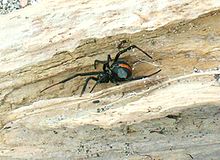
New Zealand has 1157 described spider species, with an estimated total fauna of 2000 species.[1][2][3] Over 97 per cent are endemic, and the rest have been introduced through human activities or were natural wind-borne introductions.[1][3]
The New Zealand spider with the largest leg span is the Nelson cave spider (Spelungula cavernicola), with a leg span of up to 13 centimetres (5.1 in) and a 3 centimetres (1.2 in) body length.
The Australian white-tailed spider, first recorded in New Zealand in 1886, has been falsely attributed as the cause of many necrotising spider bites.[4]
The flat huntsman spider (Delena cancerides), also from Australia, and called the Avondale spider in New Zealand, was accidentally introduced in the early 1920s, possibly in shipments of hardwood logs used for railway sleepers.[5] The huntsman spiders, which are considered harmless to humans, have been collected for use in at least two films.
Very few New Zealand spiders have bites that can cause significant injury to humans, and of these, only one – the katipō – is endemic. Katipō bites have been known to cause systemic effects, such as hypertension, seizure, or coma, though no deaths as a result of katipō bites have been recorded for over 200 years. Its more dangerous close relative, the venomous Australian redback spider, has established a foothold in some parts of New Zealand, notably in Taranaki and Central Otago.[6]
- ^ a b Manch, Thomas (25 October 2016). "A guide to New Zealand's spiders: The good, the bad and the ancient". Stuff. stuff.co.nz. Retrieved 21 September 2021.
- ^ [1] Paquin, P., Vink, C.J., Dupérré, N. (2010) Spiders of New Zealand: Annotated Family Key and Species List. Manaaki Whenua Press. vii +118 pp.
- ^ a b "Spiders". Landcare Research. Retrieved 14 December 2015.
- ^ [2] Rademaker, M. & Derraik, J. G. B. (2009) White-tail spider bites. ACC Review 42: 1-2.
- ^ Rowell and Avilés (1995). "Sociality in a bark-dwelling huntsman spider from Australia, Delena cancerides Walckenaer (Araneae: Sparassidae)". Insectes Sociaux. Volume 42(3): 287-302
- ^ Vink, Cor J.; Derraik, José G. B.; Phillips, Craig B.; Sirvid, Phil J. (2011). "The invasive Australian redback spider, Latrodectus hasseltii Thorell 1870 (Araneae: Theridiidae): Current and potential distributions, and likely impacts". Biological Invasions. 13 (4): 1003–1019. doi:10.1007/s10530-010-9885-6.